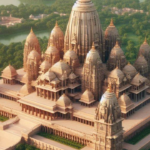Nestled in the lush hills of the Nallamala range in Andhra Pradesh, India, the Mahanandi Temple stands as an ancient testament to devotion and an architectural marvel. The temple is dedicated to Lord Shiva, one of the principal deities of Hinduism, and has a rich history that spans over a thousand years. The story of Mahanandi Temple is a captivating tale of spirituality, cultural evolution, and architectural splendor, showcasing the enduring legacy of this sacred site.
Origins and Mythological Significance
The roots of the Mahanandi Temple can be traced back to the Chalukyan dynasty, which ruled during the 7th and 8th centuries CE. According to legend, the temple is associated with the great sage Agastya, who performed intense penance at this very spot, leading to the consecration of the temple. The temple is also a part of the renowned Nava Nandi temples in the region.
Architectural Marvels
The Mahanandi Temple is an exemplary work of Dravidian architecture. Its remarkable design features intricate carvings, towering gopurams (entrance towers), and a grand mandapa (hall) that leaves visitors in awe. The temple\’s sanctum sanctorum houses a magnificent idol of Lord Shiva, the presiding deity, crafted from a single stone, reflecting the exceptional craftsmanship of ancient Indian artisans.
Historical Significance
Throughout its history, the Mahanandi Temple has weathered numerous invasions, conquests, and political changes. It witnessed the rule of various dynasties, including the Chalukyas, Cholas, and Kakatiyas, each of which contributed to the temple\’s development. The temple also became an important pilgrimage center, drawing devotees from all over India.
Religious Practices and Festivals
Devotees flock to Mahanandi to offer their prayers to Lord Shiva and seek his blessings. The temple holds several rituals and festivals throughout the year, including Maha Shivaratri, which is celebrated with great fervor. Pilgrims participate in Abhishekam, a ceremonial bathing of the deity, and circumambulate the temple as a part of their religious journey.
Historical Evolution
Over the centuries, Mahanandi Temple underwent several renovations and enhancements. Each dynasty that ruled over the region added to its architectural splendor. During the Kakatiya dynasty\’s reign, the temple was adorned with intricate carvings and sculptures. The Hoysala kings further enriched its design, and their contributions continue to astonish visitors to this day.
Restoration and Preservation
The temple, like many ancient structures, faced the test of time. Neglect, natural disasters, and wear and tear threatened its existence. However, concerted efforts by the government, archaeological departments, and local communities have ensured its preservation. Restoration work has been carried out to protect the temple\’s heritage and architectural magnificence.
Spiritual Significance
Mahanandi Temple is not just a historical monument; it is also a place of spiritual significance. It provides solace to countless devotees who come seeking inner peace and divine blessings. The serene surroundings and the sacred atmosphere of the temple make it a perfect place for meditation and self-reflection.
The Temple Complex
The Mahanandi Temple complex is a sprawling area with lush gardens, prakarams (encircling pathways), and several smaller shrines dedicated to different deities. The complex also includes a kalyana mandapam (marriage hall) where religious ceremonies and weddings are conducted.
Local Culture and Economy
The temple has played a pivotal role in shaping the local culture and economy. It has been a source of livelihood for many who provide various services to the pilgrims, such as priests, flower vendors, and local artisans. The town of Mahanandi thrives on the economic activities generated by the temple.
The Future
As Mahanandi Temple continues to inspire awe and devotion, it stands as a timeless beacon of India\’s rich spiritual and architectural heritage. The temple\’s future is a testament to the enduring legacy of Hinduism and the unwavering dedication of its devotees.
Conclusion
The Mahanandi Temple is more than just an architectural wonder; it is a sacred repository of history, spirituality, and cultural heritage. As it stands tall amidst the rolling hills of Andhra Pradesh, this temple serves as a bridge between the past and the present, reminding us of the enduring power of faith, artistry, and devotion. In its resplendent beauty and profound spirituality, Mahanandi Temple remains an eternal source of inspiration for generations to come.






